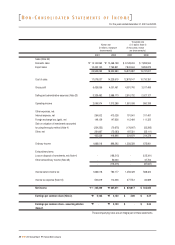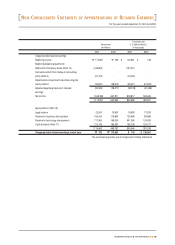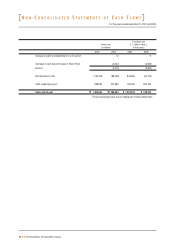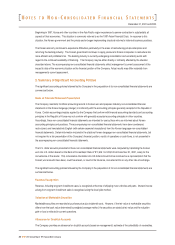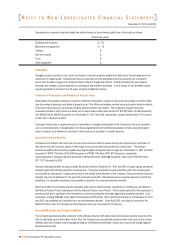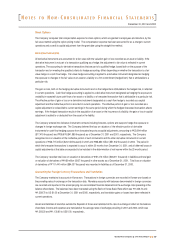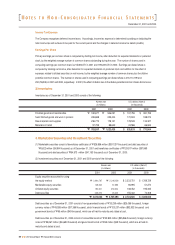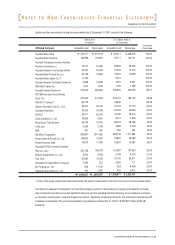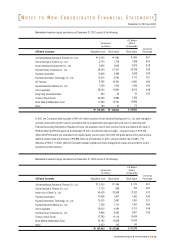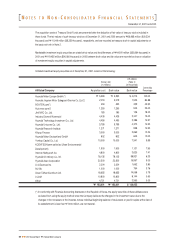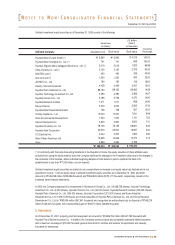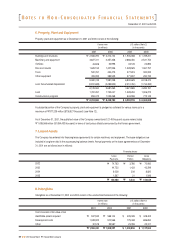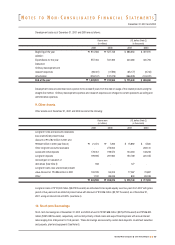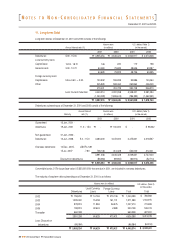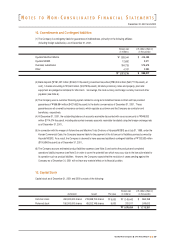Hyundai 2001 Annual Report Download - page 47
Download and view the complete annual report
Please find page 47 of the 2001 Hyundai annual report below. You can navigate through the pages in the report by either clicking on the pages listed below, or by using the keyword search tool below to find specific information within the annual report.
December 31, 2001 and 2000
Stock Options
The Company computes total compensation expense for stock options, which are granted to employees and directors, by the
fair value method using the option-pricing model. The compensation expense has been accounted for as a charge to current
operations and a credit to capital adjustment from the grant date using the straight-line method.
Derivative Instruments
All derivative instruments are accounted for at fair value with the valuation gain or loss recorded as an asset or liability. If the
derivative instrument is not part of a transaction qualifying as a hedge, the adjustment to fair value is reflected in current
operations. The accounting for derivative transactions that are part of a qualified hedge, based both on the purpose of the
transaction and on meeting the specified criteria for hedge accounting, differs depending on whether the transaction is a fair
value hedge or a cash flow hedge. Fair value hedge accounting is applied to a derivative instrument designated as hedging
the exposure to changes in the fair value of an asset or a liability or a firm commitment (hedged item) that is attributable to a
particular risk.
The gain or loss, both on the hedging derivative instruments and on the hedged item attributable to the hedged risk, is reflected
in current operations. Cash flow hedge accounting is applied to a derivative instrument designated as hedging the exposure to
variability in expected future cash flows of an asset or a liability or a forecasted transaction that is attributable to a particular risk.
The effective portion of gain or loss on a derivative instrument designated as a cash flow hedge is recorded as a capital
adjustment and the ineffective portion is recorded in current operations. The effective portion of gain or loss recorded as a
capital adjustment is reclassified to current earnings in the same period during which the hedged forecasted transaction affects
earnings. If the hedged transaction results in the acquisition of an asset or the incurrence of a liability, the gain or loss in capital
adjustment is added to or deducted from the asset or the liability.
The Company entered into derivative instrument contracts including forwards, options and swaps to hedge the exposure to
changes in foreign exchange rate. The Company deferred the loss on valuation of the effective portion of derivative
instruments for cash flow hedging purpose from forecasted exports as capital adjustments, amounting to "23,094 million
($17,415 thousand) and "55,676 ($41,985 thousand) as of December 31, 2001 and 2001, respectively. The Company
recognized loss on valuation of the ineffective portion of such instruments and the other derivative instruments in current
operations of "26,715 million ($20,146 thousand) in 2001 and "68,880 million ($51,942 thousand) in 2000. The period in
which the forecasted transactions is expected to occur is within 20 months from December 31, 2001, and all deferred losses in
capital adjustments at that date are expected to be included in the determination of net income within the 20 month period.
The Company recorded total loss on valuation of derivatives of "61,413 million ($46,311 thousand) in liabilities and total gain
on valuation of derivatives of "168 million ($127 thousand) in other assets as of December 31, 2001. Total loss on valuation
of derivatives of "111,441 million ($84,037 thousand) was recorded in liabilities as of December 31, 2000.
Accounting for Foreign Currency Transactions and Translation
The Company maintains its accounts in Korea won. Transactions in foreign currencies are recorded in Korean won based on
the prevailing rates of exchange on the transaction date. Monetary accounts with balances denominated in foreign currencies
are recorded and reported in the accompanying non-consolidated financial statements at the exchange rates prevailing at the
balance sheet dates. The balances have been translated using the Bank of Korea Basic Rate which was "1,326.10 and
"1,259.70 to US $1.00 at December 31, 2001 and 2000, respectively, and translation gains or losses have been reflected in
current operations.
Assets and liabilities of branches outside the Republic of Korea are translated at the rate of exchange in effect on the balance
sheet date; income and expenses are translated at the average rates of exchange prevailing in 2001 and 2000, which was
"1,293.20 and "1,130.60 to US$1.00, respectively,.
N
OTES TO
N
ON
-C
ONSOLIDATED
F
INANCIAL
S
TATEMENTS
49
2001 Annual ReportHyundai Motor Company



